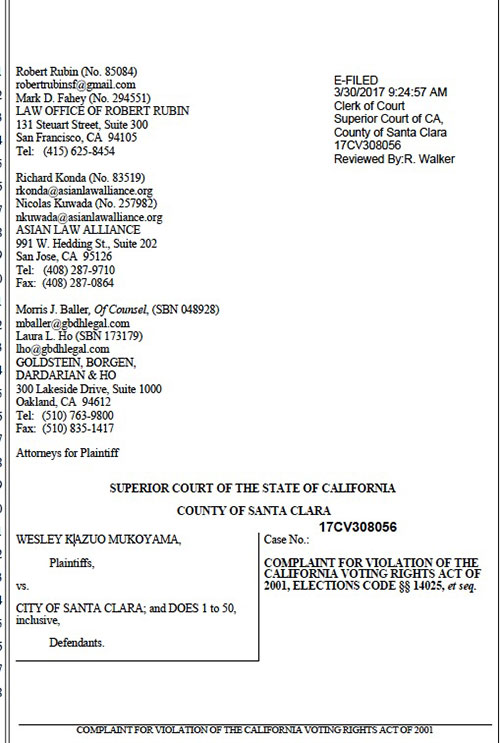For six years the Council failed to act despite warning signs that the City’s at-large, by-seat election system was on course for a costly California Voting Rights Act (CVRA) challenge.
A CVRA lawsuit threatened by civil rights attorney Robert Rubin in 2011 and 2016 became a reality last Thursday, when Santa Clara resident Wesley Mukoyama, represented by Rubin and the Asian Law Alliance (ALA), filed a suit against the City of Santa Clara.
Founded by Santa Clara University law school students in 1975, the ALA provides legal assistance, voter education and citizenship information. “We would not have been involved [in the CVRA suit] except for the strong evidence that the voting rights law has been broken,” said ALA Executive Director Richard Konda.
As of press time, the Santa Clara City Attorney hasn’t responded to the Weekly’s request for comment.
Rubin’s 2016 letter was received by the City on Oct. 13 and first reported by the Weekly. The Council, however, didn’t put Rubin’s letter and the litigation threat on its agenda until after the 2016 election.
The suit charges that “minority voters are largely unable to elect the candidates of their choice or otherwise influence the outcome of City Council elections … Since 1951, when the current City Charter was adopted, no Asian-American has been elected to the City Council, even though Asian-Americans currently make up approximately 30.5% … of eligible voters and numerous Asian-American candidates have run for the City Council in recent years.”
“Such candidates are unable to secure election to the City Council,” the complaint continues, “due to the costly and discriminatory at-large system by which the City elects its City Council, and the persistence of racially polarized voting in the City. A different electoral system, such as district-based elections, would allow this ethnic minority population to elect its chosen candidates to the City Council.”
California’s voting rights law removes federal requirements that voting rights lawsuits prove intentional discrimination. Instead, it just has to be shown that the election method–specifically, at-large election–operates in a way that prevents the election of minorities by diluting minority votes.
A 2011 demographic study found that Santa Clara’s population is 39 percent Asian-American, 36 percent white and 19 percent Hispanic. The study also found that the City’s population is homogenous–neighborhoods reflect the citywide demographics–so election districts wouldn’t necessarily change the picture.
Current Council Members are all white and only one is younger than 50.
Five Asian-American candidates ran in the 2016 election. None won. Two of them, Mohammad Nadeem and Ahmad Rafah, both Muslims and immigrants, were among the five targets of a $85,000 negative campaign funded by the Santa Clara Police Officers Association (POA), several developers and the California Apartment Association, and executed by the POA PAC.*
Since 2011 the City has convened two charter review committees, with a third on the drawing board for this year.
The 2011 committee recommended changing the voting system to a fully at-large system until the County Registrar of Voters had software that could handle instant run-off voting. In Feb. 2012 the Council voted to continue the question until after the 2012 elections.
The second charter review committee, convened in January 2016, decided not to consider the question entirely, recommending that the Council form another committee.
CVRA lawsuits are expensive. The defendant must pay the plaintiff’s legal bills even if the case doesn’t go to court.
Whittier changed its election system in the face of a CVRA lawsuit, but still had to pay the plaintiffs’ attorneys almost $1 million. Modesto’s 2006 CVRA lawsuit went all the way to the U.S. Supreme Court, which declined to hear it, and cost Modesto taxpayers about $5 million.
In 2015, Palmdale settled a years-long CVRA lawsuit for $4.5 million plus interest.
But money isn’t the only cost of a CVRA lawsuit.
The judge who found Palmdale in violation of the CVRA refused to certify the city’s 2013 council election. Instead, he ordered the city to establish election districts drawn by the court and hold a special election to replace the sitting council.
Case No. 17-CV-308056 is scheduled for an initial hearing on July 28 at 10 a.m. in Santa Clara Superior Court Dept. D5.
*2016 political donations and spending are public and available on SantaClaraCA.gov and at the City Clerk’s office.
Share your thoughts. Email a letter to scweekly@ix.netcom.com for publication. Please include your name and phone number with your submission–phone numbers will not be published. Letters to the Editor should be limited to one hundred and fifty words.
